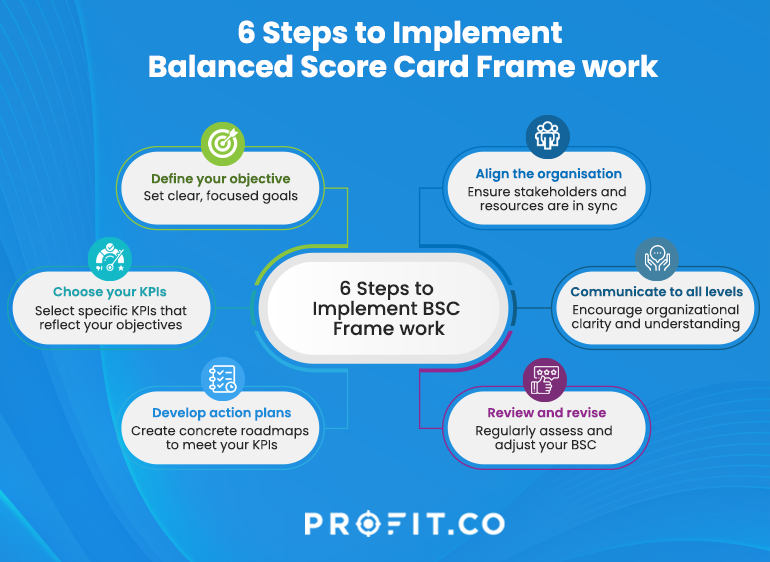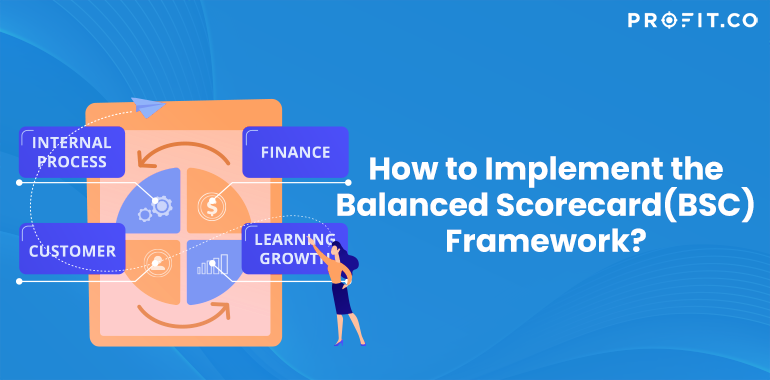Why use a Balanced Scorecard?
If you have worked long enough in a professional space, you would have come across the balanced scorecard concept. It is used to measure internal performance and the resulting outputs. Today, it is a popular tool used in for-profits, non-profits, and government agencies, emphasizing its versatility. The essence of its success lies in its initial simplicity, where it divides a business’ operations into four categories:
- Learning and growth
- Business Processes
- Customers
- Finance
Though separate, it is important to recognize that these categories are deeply interlinked and success in one means progress in the other three. However, more than its usefulness, we want to explore how you can implement the balanced scorecard into your business. The premise is that regardless of industry, the balanced scorecard is still applicable if introduced correctly.
To learn more about how to implement BSC in your organization
Key Approaches to Implementing the Balanced Scorecard
Implementing the Balanced Scorecard requires a strategic approach, focusing on translating an organization’s vision into clear operational objectives. It’s about balancing financial metrics with performance indicators like internal processes, customer perspectives, and organizational growth.
Linked Leadership and Implementation Teams (Organizational Readiness Building): Successful implementation of the Balanced Scorecard involves forming dedicated teams comprising members from various organizational levels. These teams are trusted with leadership and management activities crucial for effective implementation. They utilize tools and resources to assess, monitor, and improve corporate culture and processes, ensuring they align with the Balanced Scorecard’s objectives.
“Effective leadership begins with having the right mindset; in particular, it begins with having an ownership mindset.”
Workforce and Professional Development: Ongoing professional development plans are vital. These plans, training, and coaching based on adult learning best practices are integral to building the confidence and skills necessary at all levels. This focus ensures that staff can effectively deliver and support the Balanced Scorecard.
Engagement, Relationships, and Partnership: Implementing the Balanced Scorecard requires active involvement from internal stakeholders and partners. This collaborative effort aids in establishing culturally relevant supports and services, detecting practice changes, and fostering communication for continuous improvement.
Quality, Outcome, and System Monitoring for Improvement: An essential aspect of implementing the Balanced Scorecard is consistently monitoring implementation processes, practices, and outcomes. This involves collecting, sharing, reviewing, and using data strategically to address challenges and improve practices.
6 Steps to Implement a Balanced Scorecard

To that end, the following are essential steps to guide you toward implementing the balanced scorecard:
Define your Objective
You can only decide whether your performance is good if you have a clear idea of what you are working towards. Say you are a non-profit organization that focuses on social aid. More specifically, your goal is to assist homeless individuals in gaining employment and becoming self-sufficient. With that in mind, you can decide the outcomes for each section. The customer section would be how helpful the homeless people feel you are. Were you instrumental in their success? Financially, the outcome you would focus on would be raising funds to assist those you help while making it a completely transparent process. The same follows for the other categories.
Choose your KPIs
If you know your desired outcomes, you will need ways to measure progress. This is where Key Performance Indicators are important. You need to set specific, time-bound, and measurable metrics that allow you to keep track of your business. Continuing the previous example, your financial KPI would be to increase revenue from fundraising, with a clear minimum you need to achieve within, say, six months. The customer section would be slightly counter-intuitive to a profit-making business, where instead of increasing the retention rate of customers, you want to reduce it as that’s the objective of your business. You can choose as many KPIs as necessary, but they should be relevant and easy to ascertain.
Develop Action Plans
Working with your KPIs, you should find the best ways to assist your employees in achieving their goals. If there is room for improvement in the financial section, either change the fundraising style or appeal to a new base. Customer-wise, helping homeless people with employment would mean keeping up with modern hiring practices and providing resources for the homeless people to be presentable. Identifying what is effective is essential and ensuring your employees are trained for it.
Align the Organisation
Once you’ve formed the framework for your balanced scorecard, you must ensure your organization is built to accommodate it. That means ensuring resources are properly allocated to where your scorecard says they are most needed or that your employees are placed in positions most suited to achieving specific KPIs. For example, you realize that an essential part of enabling the homeless population in your area is to have strong ties to the local community. Therefore, you create and encourage a culture of openness that facilitates this through employee guidelines. The rules and regulations you make should not simply fit a template, rather, they should be formed around your balanced scorecard.
Communicate to all Levels
The most well-thought-out plan is only useful if the stakeholders are informed. An employee should have clarity on where their work fits on the balanced scorecard and should be able to evaluate their progress. For example, the KPIs for the customer section should inform an employee that those homeless who come back frequently might need more help than others. Those working in the revenue sections should be able to tell early on if they cannot make their goal and why this is happening. How a balanced scorecard is presented and explained to your workforce can determine success.
Review and Revise
The most important part is to periodically re-inspect your balanced scorecard. Ideally, you would achieve a level of success in your objectives, which means you have the resources to focus on other sections. Or the KPIs you have set do not truly reflect the performance you care about, so you could scrap them early on and choose new ones. Regardless of why, it is vital to give yourself the time and space to reflect on your work. It saves a headache later on.
These steps are broad so that anyone can implement them into their business. Regardless of your background or position, you should be able to create a framework for a balanced scorecard. It doesn’t matter if your business is new or old. The system is flexible so that it will accommodate.
The Impact of Deliberate Attention in Implementation
Deliberate attention during Balanced Scorecard implementation ensures maximum effectiveness and alignment with organizational objectives.
- Fosters a supportive environment for strategic application
- Customizes implementation for organizational uniqueness
- Leverages data for ongoing refinement and improvement
- Involves leadership at all levels for effective change
- Enhances stakeholder collaboration in implementation
- Enables regular evaluation of strategy effectiveness
Conclusion
In today’s era of automation, leveraging digital tools can significantly streamline the implementation of a balanced scorecard. As you navigate the outlined steps, consider integrating Balanced Scorecard Software or similar digital solutions. These can simplify and enhance the process, reducing manual workload and bringing efficiency to your strategic management efforts. By embracing technology, you can apply the balanced scorecard framework more effectively, ensuring a more agile and responsive approach to achieving your organizational goals.

